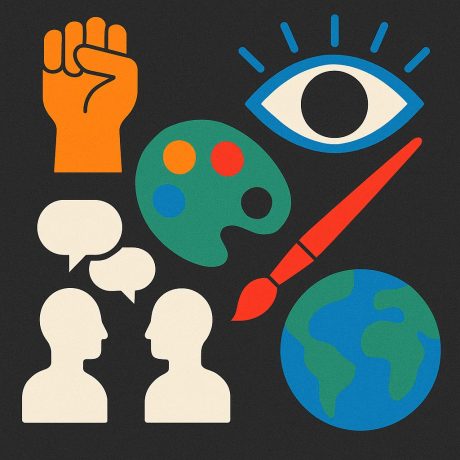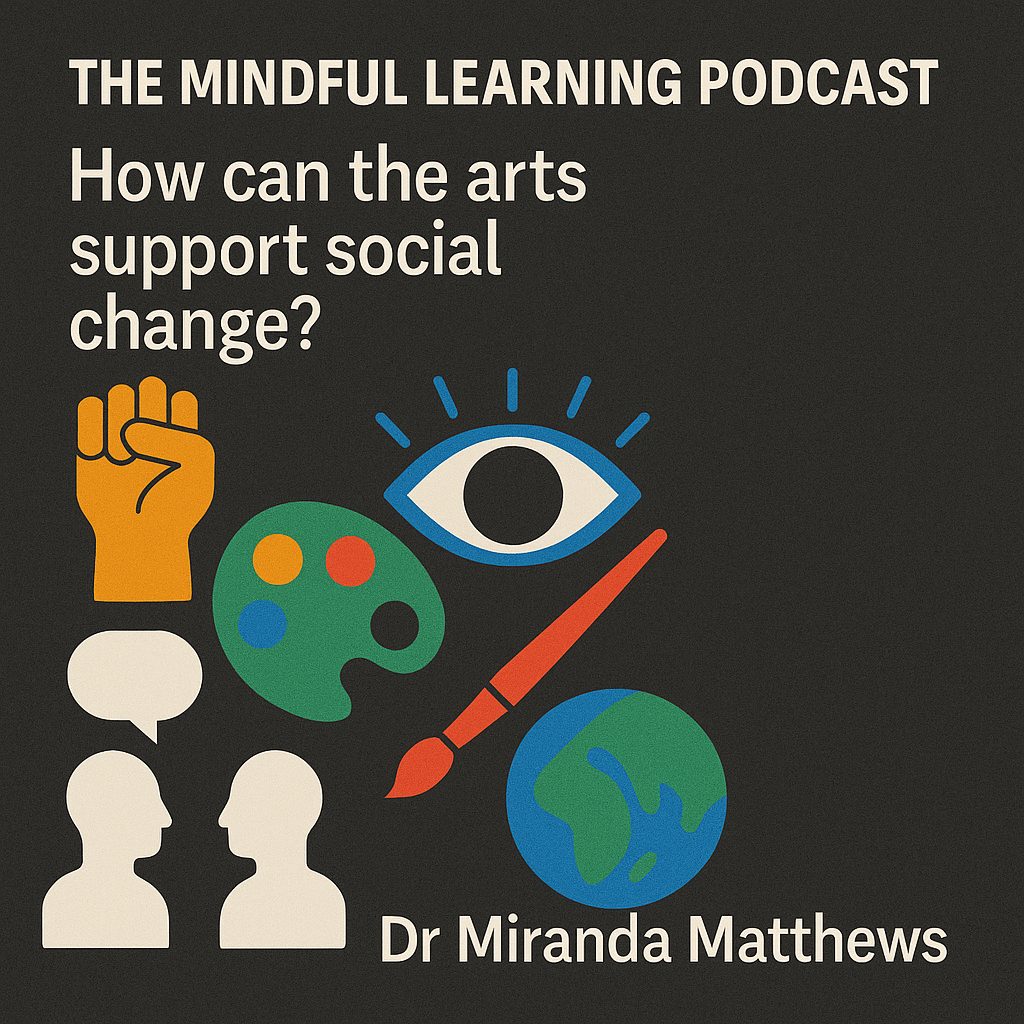This article draws on the latest episode of the Mindful Learning Podcast, in which I spoke to Dr Miranda Matthews—incoming Head of the MA Arts and Learning at Goldsmiths and editor of the recent volume Ecologies in Learning and Practice: Arts Interventions in the Earth Crisis (2025). The podcast, embedded above, explores how arts practice can ignite meaningful social change. What follows is a summary of five key insights from our conversation, with selected quotes and references to Miranda’s major works.

1. Arts Practice Creates ‘Withness’—a Foundation for Transformative Learning
Miranda began the conversation by describing her journey from being a practicing artist to becoming a teacher educator. A key theme that emerged was withness: the sense of being creatively and reflectively with others. She described how this concept, rooted in critical pedagogy, shapes the ethos of the MA Arts and Learning programme and its final exhibition in July 2025, titled Withness, exploring as it does the ways in which artists and teachers can be ‘with’ their audiences and learners, rather than didactically instructing them:
“That feeling of withness, of being with people, is absolutely vital for education… It opens ways for discussion and participation, encouraging different ways of seeing and being.”
This ties directly to the dialogic, participatory ethos promoted by theorists like bell hooks and John Berger—both of whom Matthews credits as major influences. As she explains:
“Bell hooks had a perspective on teaching to transgress… teaching to actually change things—not just copying the canon but valuing everybody’s cultural starting points.”
2. Creative Practice Can Offer Powerful Responses to the Climate Crisis
Matthews’ latest edited collection, Ecologies in Learning and Practice (Palgrave Macmillan, 2025), curates 29 international case studies of arts-based responses to ecological crisis. In the podcast, she described how these projects originated from her curation of the Centre for Arts and Learning’s annual theme and evolved into a broad-based collaboration:
“We ran a whole year of events around ecology… and then developed a partnership with the Climate Museum UK, working with schools, artists, and researchers. We created drawing, sound, and writing workshops—students aged 14 to 15 worked with dialogical objects, soundscapes, and co-created materials.”
She spoke movingly about her ongoing collaboration with Theatre X (Bangladesh), whose films about climate injustice have been screened at UNESCO and other global venues:
“They’re experiencing devastating consequences—displaced children, rising sea levels. We wanted to create work that travels and speaks to those issues globally.”
3. Arts Methods Give Voice to Marginalised Experiences
Matthews’ earlier book, Arts Methods for the Self-Representation of Undergraduate Students (Routledge, 2023), makes a compelling case for the role of creative practice in surfacing student identity, voice, and sensory experience. As she explained in the podcast, this work grew from her desire to resist dominant, quantifiable approaches to knowledge:
“Art allows us to represent diverse subjectivities—what it means to feel, to be marginalised, to create. One academic recently told me she had redesigned a programme based on that book. That’s impact.”
She links this ethos to her own art practice, recalling her striking performance piece where she wore a neoprene seal suit to embody Celtic selkie mythology:
“I was told I was too sensitive. So I made another skin. It was about escaping domestic roles, reclaiming myth, and exploring what it means to live differently… I even took it to a seal sanctuary in Oban.”
Miranda’s playfully serious approach is exemplified by her donning of the selkie suit I feel. She wore it in different contexts, exploring her own, other people’s and animals’ experience of it. This story exemplifies her commitment to posthuman and new materialist thinking—arts practice as a mode of becoming, of transformation.
4. Training Arts Educators Multiplies Social Impact
Matthews emphasised the importance of working with teachers to amplify change. Her work at Goldsmiths with PGCE Arts and Design and MA Arts and Learning students is grounded in the idea that teachers, as creative agents, can cascade socially engaged practices into schools, galleries, and communities.
“We created resources for schools, trialled them with teachers, and saw how they travelled—one teacher made a climate mural, then moved to a new school and did the same there.”
“Even small groups can have wide reach. Teachers shape the futures of hundreds of learners. That’s why training them with arts methods is so important.”
This philosophy underpins the partnerships she’s helped establish with the British Ecological Society and museum educators such as those at the Whitechapel Gallery, where participation, not just education, is now a central goal.
5. The Arts Make Space for Qualitative, Narrative-Led Change
Throughout the conversation, Matthews returned to the idea that stories, not statistics, often provide the most meaningful evidence of social change. She warned against reducing arts impact to instrumental outcomes:
“Even big numbers are made of small ones. What matters are the stories of change—how a single sentence, a single artwork, can lead someone to rethink their world.”
This view challenges the narrow frameworks often imposed by funding bodies or institutions and insists instead on the experiential, affective, and long-term value of arts-based learning.
“The change isn’t always immediate. Sometimes it sneaks up. A conversation, a workshop, a podcast—these things ripple outwards.”
Listen to the full podcast
The full interview with Dr Miranda Matthews is available above. If you’re interested in arts education, ecological pedagogy, or participatory methods, this conversation offers both practical inspiration and intellectual depth.
Further Reading
Matthews, M. (ed.) (2025). Ecologies in Learning and Practice: Arts Interventions in the Earth Crisis. Cham, Switzerland: Palgrave Macmillan. Available here
Matthews, M. (2023). Arts Methods for the Self-Representation of Undergraduate Students: Sensory and Mediated Perspectives. Abingdon: Routledge. Available here
The MA Arts and Learning website is here. Do consider this exciting Masters’ degree! You can follow them on Instagram here.


Leave a Reply